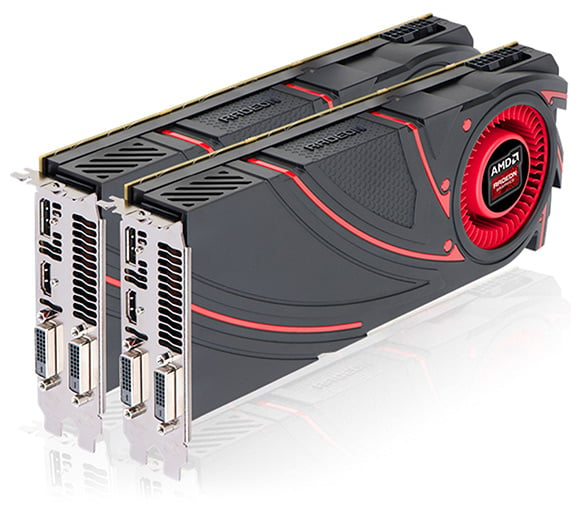Introduction and Specifications
AMD has been making quite a bit of news the last few weeks, thanks in part to a multi-day event the company held in Honolulu, Hawaii to announce its next-gen graphics products and a few new related technologies. Of course, the recent release of its Radeon R7 and R9 series of products on October 8 generated plenty of buzz as well.
In case you missed it, the event in Hawaii was broken up into a few segments, some of which were broadcast publicly and a few that were kept under embargo until new products were ready for prime time. We covered all of the public announcements in these recent articles, should you want to a quick refresher:
- AMD and DICE Bring Low-Level, High-Performance Graphics API To PCs With "Mantle"
- AMD and Raptr Take on NVIDIA’s GeForce Experience with New AMD Gaming Evolved Utility
- AMD Unveils New Family of GPUs: Radeon R7 and R9, With Exclusive Battlefield 4 Preorder
To recap, AMD’s Mantle is a low-level API that’s designed to allow game developers to work ‘closer to the metal’ so to speak, to more efficiently exploit the features and performance capabilities of AMD’s GCN-based graphics processors. Mantle is being co-developed with DICE, the makers of the Frostbite engine, and will debut in a patch coming in December for the hotly anticipated game Battlefield 4.
AMD's Gaming Evolved App powered by Raptr gives AMD graphics card owners the ability to easily optimize their in-game settings with customized, optimal game profiles. Users of the utility will also accumulate real-life and digital rewards and will have the ability to live stream their games via sites like Twitch. The goal of the utility is to provide a simple, more console-like experience for PC gamers, looking to optimize the look and performance of their games without having to manually fiddle with complicated in-game menu systems. The concept is similar to NVIDIA’s GeForce Experience app, though it doesn’t leverage any AMD-proprietary information—it’s crowd sourced.
Which brings us to the launch of the Radeon R7 and R9 series of products. A couple of weeks back we were able to give you a glimpse at the Radeon R7 260X, Radeon R9 270X and Radeon R9 280X. Though these cards have new branding, they are all actually based on existing GPU designs. Through the use of higher frequencies and tweaked memory configurations, the new Radeon R7 and R9 series cards we looked at were measurably faster than their previous-gen counterparts, but technically they’re not all new. You can check out our coverage right here:
The Radeon R7 260X, R9 270X, and R9 280X also hit the market at lower price points than the Radeon HD-series parts using the same GPUs, which enhanced their overall value proposition. The Radeon R9 280X looked particularly appealing, considering it offered similar performance to the Radeon HD 7970 GHz Edition, but at a sub-$300 price point. Due to some confusion in the lead-up to that article, however, we weren’t able to show you all of the AIB cards produced by AMD’s partners on launch day. As such, we’ve included a couple of new R7 and R9 series cards in this piece as well, namely the MSI R7 270X HAWK and the ASUS Radeon R9 280X DirectCU II. As you’ll see a little later, they’re both pretty slick.
The AMD Radeon R9 290X Is A Go
One of the biggest pieces of news to come out AMD’s event, however, was the announcement of the Radeon R9 290 and R9 290X. The cards weren’t ready in time for the October 8 launch, but the top of the line model, based on the GPU codenamed Hawaii, is ready now and we’re going to show it to you here in all its glory today.
The AMD Radeon R9 290X - Gigabyte's Is On Sale Now At Amazon
|
| Radeon R9 290X | ||
| Stream Processors | 2,816 | |
| Engine Clock | Up to 1 GHz | |
| Compute Performance | 5.6 TFLOPS | |
| Memory Configuration | 4GB GDDR5 / 512-bit | |
| Memory Speed | 5.0 Gbps | |
| Power Connectors | 1 x 6-pin, 1 x 8-pin | |
| PCI-E Standard | PCI-E 3.0 | |
| AMD TrueAudio Technology | Yes | |
| API Support | DirectX 11.2 OpenGL 4.3 Mantle |
|

Radeon R9 290X CrossFire -- Dongles No Longer Required
The Radeon R9 290 and 290X are both based on the same GPU, but we’ll have to withhold other details about the R9 290 until a little later. As you can see in the specification table above, the Radeon R9 290X features 2816 Stream Processors and an engine clock of up to 1GHz. It says “up to” instead of a firm number because of some changes made to AMD’s PowerTune technology, which we’ll talk about on the next page. The card’s 4GB of GDDR5 memory are connected to the GPU via a wide 512-bit interface and R290X requires a pair of supplemental power connectors—one 6-pin and one 8-pin. There’s plenty more to talk about too, like a new CrossFire interface that eliminates the need for a dongle, a more flexible output configuration for Eyefinity, and TrueAudio support, among a few other things. We should probably just get to it...






